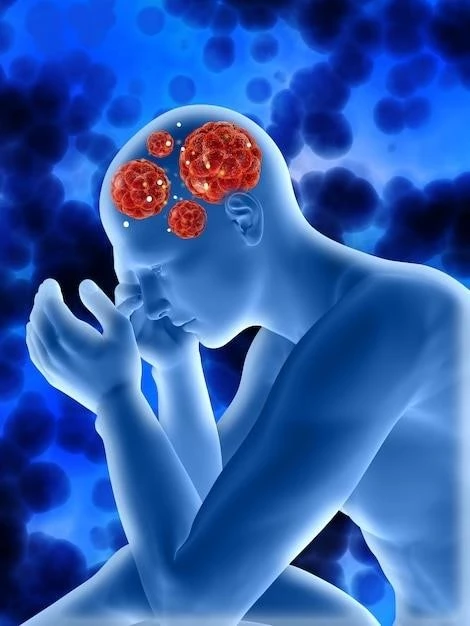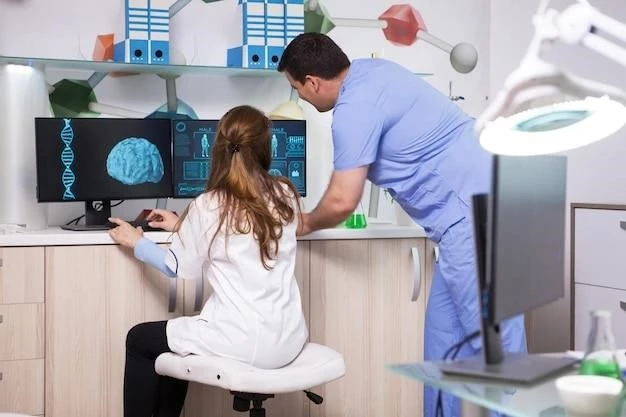Article Plan⁚ Disease ー Neurofibromatosis Type 2
Introduction to Neurofibromatosis Type 2
Neurofibromatosis type 2 (NF2) is a genetic disorder that causes noncancerous tumors to grow on the nervous system. Apart from NF2, there are two other types⁚ Neurofibromatosis type 1 (NF1) and Schwannomatosis. NF2 commonly presents with symptoms like vestibular schwannomas, affecting both ears, and other tumors involving the central nervous system.
Individuals with NF2 have mutations in the Merlin gene, impacting cell form and movement. The primary treatment options include surgical removal of tumors and eye lesion surgery. Patients with NF2 may develop schwannomas on nerves in the brain, spinal cord, and other body areas, affecting hearing and balance.
Genetic Basis of NF2
Neurofibromatosis type 2 (NF2) is an autosomal dominant disorder caused by mutations in the Merlin gene٫ also known as the NF2 tumor suppressor gene located on chromosome 22q. These mutations affect cell form and movement٫ leading to the development of multiple tumors in the central nervous system. Unlike Neurofibromatosis type 1 (NF1)٫ NF2 is not associated with neurofibromas but presents with tumors such as vestibular schwannomas٫ meningiomas٫ and ependymomas.
Individuals inheriting a germline mutation from an affected parent have a nearly 100 penetrance of NF2 by 60 years of age. One in 25,000 live births is affected by NF2, making it a rare genetic disorder. The most common manifestation of NF2 are bilateral vestibular schwannomas, present in about 90-95% of patients, while meningiomas are seen in approximately 50% of individuals with NF2.
Studies have shown that early diagnosis and treatment play vital roles in the prognosis of NF2. Treatment options include neurosurgical removal of tumors and surgical interventions for associated eye lesions. Despite historically limited therapeutic options for NF2 due to the nature of cell mutations, ongoing research aims to develop new treatments and improve the quality of life for individuals living with NF2.
Symptoms and Clinical Presentation
Neurofibromatosis type 2 (NF2) manifests with various symptoms affecting the nervous system. Individuals with NF2 may experience symptoms like hearing loss, tinnitus, imbalance, and facial weakness. Vestibular schwannomas, commonly known as acoustic neuromas, are a hallmark feature of NF2, impacting both ears and causing hearing difficulties. Other clinical presentations include meningiomas, ependymomas, and schwannomas affecting the central nervous system.

Furthermore, NF2 can lead to vision problems, facial numbness, and weakness due to the growth of tumors on cranial nerves. Individuals may also develop spinal cord tumors, causing issues with mobility and sensation. Symptoms typically begin to appear between the ages of 18 and 22, although the severity and onset can vary among affected individuals.
Early recognition of these symptoms is crucial for timely diagnosis and treatment of NF2. Due to the diverse range of tumors associated with NF2٫ a comprehensive clinical evaluation by healthcare professionals specializing in neurofibromatosis is essential to determine an accurate diagnosis and establish an appropriate management plan tailored to the individual’s unique symptoms and needs.
Diagnosing Neurofibromatosis Type 2
Diagnosing neurofibromatosis type 2 (NF2) involves a combination of clinical evaluation, imaging studies, and genetic testing. Medical professionals typically conduct a thorough physical examination to assess symptoms such as hearing loss, balance issues, and vision problems. Imaging tests, including MRI and CT scans, help identify tumors on the nervous system, with bilateral vestibular schwannomas being a common finding in NF2.
Genetic testing plays a crucial role in confirming a diagnosis of NF2 by detecting mutations in the NF2 gene, also known as the Merlin gene. Individuals with a family history of NF2 may opt for genetic testing to determine their risk of inheriting the genetic mutation associated with the condition. Once a diagnosis is established, healthcare providers can develop a tailored treatment plan to address the specific symptoms and tumor manifestations present in each individual.
Treatment Options for NF2
Treatment options for Neurofibromatosis Type 2 (NF2) focus on managing symptoms and tumor growth. Surgical interventions are commonly used to remove tumors, especially vestibular schwannomas affecting hearing and balance. In some cases, radiation therapy may be employed to target tumors that are difficult to access surgically.
Hearing loss and balance issues associated with NF2 can be addressed through hearing aids, cochlear implants, or vestibular rehabilitation therapy. Regular monitoring through imaging studies is crucial to track tumor progression and assess the effectiveness of treatment. Clinical trials investigating new therapies and approaches for NF2 management are ongoing to improve outcomes for individuals with this condition.
Prognosis and Complications of NF2
Neurofibromatosis type 2 (NF2) carries a varied prognosis depending on the individual’s tumor burden and response to treatment. Complications of NF2 can include progressive hearing loss, balance issues, facial weakness, and vision problems. Due to the location of tumors in the central nervous system, neurological deficits can worsen over time, impacting daily functioning.
While not typically life-threatening, NF2 can significantly affect the quality of life due to the development and growth of schwannomas and meningiomas. Complications from surgical interventions to remove tumors can also arise, including nerve damage and infection. Regular monitoring by healthcare professionals is essential to address any emerging complications promptly and adjust the treatment plan as needed to optimize outcomes for individuals with NF2.
Research and Advancements in NF2
Research into Neurofibromatosis Type 2 (NF2) focuses on understanding the genetic basis of the condition and developing targeted therapies to treat the associated tumors effectively. Recent advancements in NF2 research include genetic sequencing technologies that allow for the identification of specific mutations in the NF2 gene, aiding in personalized treatment approaches.
Clinical trials are underway to test novel treatment strategies, such as gene therapies and immunotherapies, to improve outcomes for individuals with NF2. Additionally, research efforts aim to elucidate the molecular pathways involved in tumor formation in NF2, leading to the discovery of potential therapeutic targets.
Advancements in imaging techniques, such as high-resolution MRI and PET scans, contribute to early detection and monitoring of tumor growth in NF2 patients. Collaborative research initiatives among healthcare institutions and genetic research centers worldwide play a crucial role in accelerating progress in understanding NF2 and developing innovative treatment modalities for this rare genetic disorder.
Support and Resources for Individuals with NF2
Individuals with Neurofibromatosis Type 2 (NF2) can benefit from various support services and resources tailored to their specific needs. Support groups and online forums provide a platform for individuals with NF2 and their families to connect, share experiences, and receive emotional support.
Specialized healthcare professionals, such as neurologists and genetic counselors, play a crucial role in guiding individuals with NF2 through their diagnosis, treatment options, and long-term management. Counseling services can help address the emotional and psychological impact of living with NF2 and assist individuals in coping with the challenges posed by the condition.
Furthermore, advocacy organizations and research institutions dedicated to neurofibromatosis offer valuable information on the latest advancements in NF2 research, clinical trials, and treatment options. Access to educational materials and workshops can empower individuals with NF2 to make informed decisions about their healthcare and engage in proactive self-care practices to enhance their quality of life.
Conclusion⁚ Living with Neurofibromatosis Type 2
Living with Neurofibromatosis Type 2 (NF2) requires a multi-faceted approach involving medical management٫ emotional support٫ and ongoing monitoring. Individuals diagnosed with NF2 face challenges related to hearing loss٫ balance issues٫ and potential surgical interventions.

While NF2 can impact various aspects of daily life٫ advancements in treatment options and ongoing research offer hope for improved outcomes and quality of life for those with the condition. Support groups٫ healthcare professionals٫ and advocacy organizations play vital roles in providing assistance٫ resources٫ and a sense of community for individuals navigating the complexities of NF2.
By staying informed, connecting with others facing similar experiences, and actively participating in their healthcare journey, individuals with NF2 can foster resilience, empowerment, and effective management strategies to enhance their well-being while living with Neurofibromatosis Type 2.
